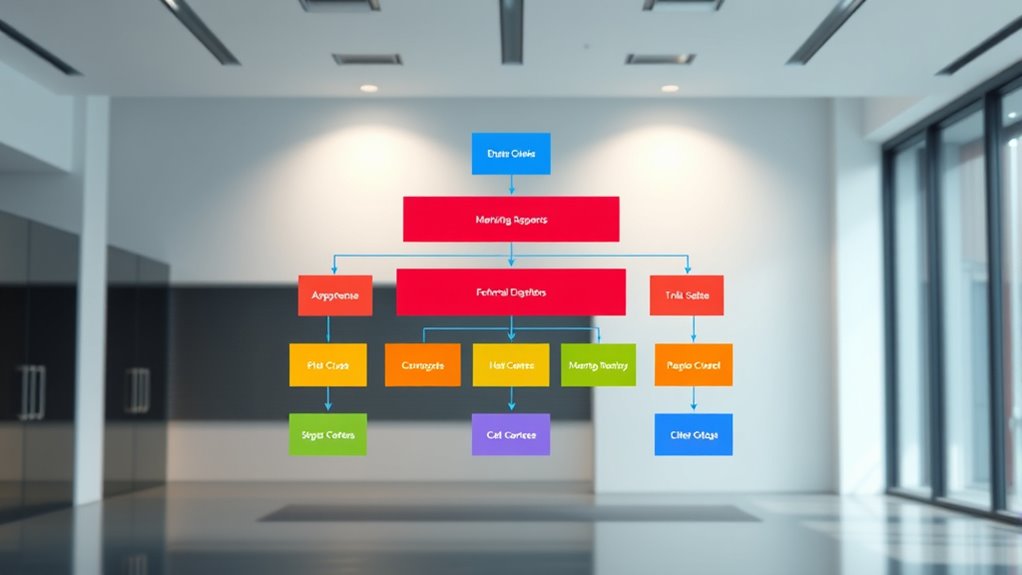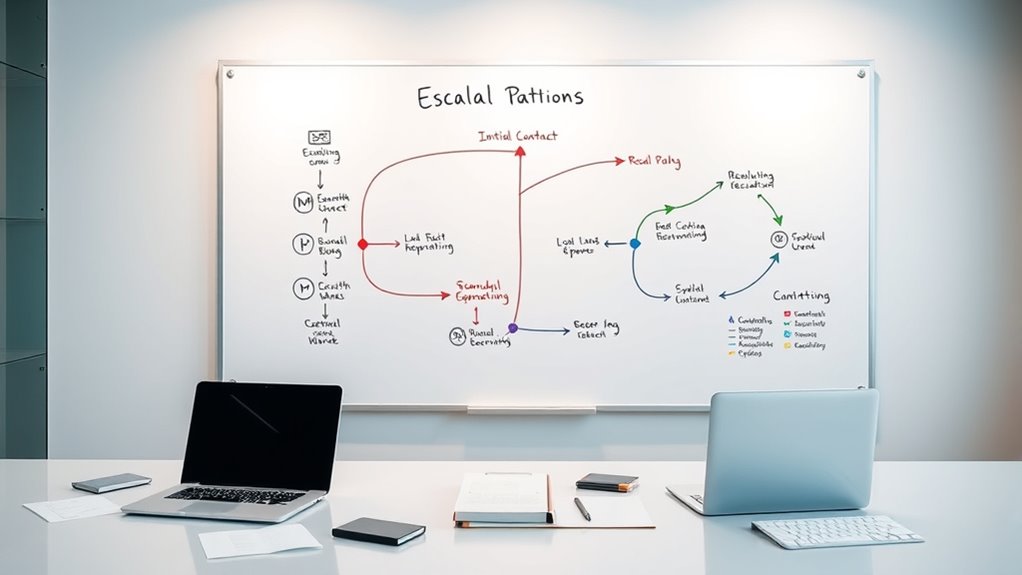Designing clear escalation paths is essential for effective conflict resolution and swift issue management. You should map your organizational structure to visualize roles, responsibilities, and communication flow. Establish specific criteria for when to escalate, ensuring everyone knows who to contact in different situations. Create simple diagrams and documentation, then train your team on procedures. Continuously improve these processes by gathering feedback and using tools that streamline responses. Keep exploring to master every step of building transparent escalation paths.
Key Takeaways
- Define clear escalation routes and role responsibilities to ensure prompt, responsible issue resolution.
- Map organizational structure and communication flow to identify decision-makers and streamline escalation paths.
- Establish specific criteria and triggers for escalation based on severity, impact, and urgency.
- Develop visual escalation diagrams and documentation for quick understanding and training.
- Continuously review, gather feedback, and refine escalation processes for ongoing clarity and efficiency.
Understanding the Importance of Clear Escalation Routes

Why are clear escalation routes essential in any organization? They play a critical role in effective conflict resolution by ensuring issues are addressed promptly and appropriately. When escalation paths are clearly defined, employees know exactly who to approach, reducing confusion and delays. This clarity promotes escalation ethics, encouraging staff to escalate concerns responsibly without bypassing proper channels. Without clear routes, small problems may escalate into larger conflicts, damaging relationships and productivity. Additionally, structured escalation processes foster trust, accountability, and transparency. When everyone understands the steps to escalate concerns, it creates a culture of openness and timely response. Furthermore, incorporating risk assessment into escalation procedures helps organizations identify potential vulnerabilities in their communication channels. Properly designed escalation paths also support technology integration, ensuring that digital tools facilitate seamless issue reporting and tracking. Clear escalation routes also enhance communication clarity, making it easier for team members to understand their roles in resolving issues efficiently. Well-designed escalation paths are vital for maintaining organizational resilience, especially during crises or unexpected disruptions. Establishing standard operating procedures for escalation ensures consistency and fairness across the organization, reinforcing trust. Ultimately, well-designed escalation paths enable your organization to handle issues efficiently, maintaining harmony and operational integrity.
Mapping Your Organization’s Structure and Communication Flow

To guarantee effective escalation, you need a clear map of your organization’s structure and communication flow. Use hierarchy charts and communication channels to identify key roles and how information moves between them. Clarifying authority and responsibilities helps prevent confusion and speeds up decision-making. Incorporating communication flow analysis inspired by sound wave research can further enhance understanding of information dynamics within your organization. Understanding organizational structure and emotional support concepts and storytelling techniques can provide insights into how narratives are effectively communicated across departments. Recognizing the importance of well-being in organizational health can also contribute to more cohesive and resilient communication practices.
Organizational Hierarchy Charts
Organizational hierarchy charts serve as visual tools that clearly depict the structure of your organization and how communication flows between different levels. They create a visual hierarchy that enhances organizational clarity, making it easier to understand roles and reporting relationships. By mapping out these levels, you can identify decision-makers and streamline escalation paths. Here are key ideas to contemplate:
- Show reporting lines to clarify authority and responsibility.
- Use visual hierarchy to differentiate between leadership tiers.
- Highlight communication flow pathways for effective information transfer.
- Simplify complex structures to improve organizational clarity and decision-making efficiency.
This approach helps you design a clear structure, ensuring everyone understands their place within the organization and how escalation should proceed.
Communication Channels Mapping
Mapping your organization’s communication channels builds on your hierarchy charts by visually representing how information flows across different levels and departments. This mapping helps identify escalation shortcuts, enabling faster decision-making and issue resolution. It reveals where communication silos might exist, preventing proper flow of critical information. By understanding these channels, you can streamline processes, ensure messages reach the right people quickly, and avoid unnecessary delays. Visual diagrams highlight gaps where escalation paths are unclear or overly complex, allowing you to optimize and clarify communication flow. Effective mapping reduces confusion during crises, minimizes miscommunication, and fosters transparency. Additionally, recognizing pump and dump schemes in market trends can help prevent misinformation from influencing your organization’s decisions. Staying aware of market manipulation tactics empowers your team to respond proactively and maintain organizational integrity. Developing clear communication protocols ensures consistent messaging during high-pressure situations, further enhancing organizational response. Understanding escalation procedures allows teams to act swiftly and confidently when urgent issues arise, preventing escalation delays. Clearly defined decision-making authority ensures that the right individuals are empowered to act quickly, further preventing delays and enabling swift responses. Ultimately, it empowers your team to escalate issues efficiently, ensuring swift action and continuous organizational alignment.
Authority and Responsibility Clarity
Understanding who has authority and responsibility within your organization is essential for ensuring clear communication and effective decision-making. When authority delegation and responsibility assignment are clear, everyone knows their roles and limits, reducing confusion. To map this effectively:
- Define key decision-makers and their specific authority levels.
- Clarify responsibilities tied to each role to avoid overlap.
- Establish a chain of command that reflects your organizational structure.
- Document authority delegation and responsibility assignments for transparency.
Defining Roles and Responsibilities at Each Level

Clearly defining roles and responsibilities at each level is essential for ensuring that everyone knows their specific duties and can work efficiently within the escalation process. With clear role clarity, team members understand who is responsible for each task and when to escalate issues. Responsibility assignment prevents confusion and overlap, enabling seamless handovers between levels. You should specify what each role entails, including decision-making authority and accountability. This clarity helps prevent delays and miscommunication during critical moments. When roles are well-defined, you empower team members to act confidently within their scope, knowing exactly when and how to escalate problems. Additionally, understanding the benefits of clear communication can improve coordination and response times. Establishing well-defined responsibility boundaries ensures that everyone knows their scope, which reduces hesitation and increases efficiency. Clear role definitions also facilitate effective delegation, allowing for smoother workflow management. This structured approach supports structured escalation paths**, making sure issues are addressed promptly and appropriately. Moreover, creating standard operating procedures** for different scenarios helps reinforce role clarity and escalation processes. Ultimately, detailed role definitions streamline escalation paths, fostering a more responsive and organized environment.
Establishing Criteria for When to Escalate

You need clear criteria to decide when to escalate issues. Focus on urgency and impact to determine if a situation requires immediate action. Also, guarantee responsibility lines are well-defined so everyone knows who should handle each escalation. Incorporating body awareness can help identify physical cues that signal when a situation might need escalation. Being familiar with the appropriate bike type can aid in assessing the severity of issues on different terrains, ensuring proper escalation when necessary. Additionally, understanding affiliate disclosures and privacy policies can help maintain transparency and trust during communication about escalations.
Urgency and Impact
Determining when to escalate an issue hinges on evaluating both its urgency and potential impact. You need to recognize which problems demand immediate action and which can wait, to ensure effective priority recognition. High-impact issues threaten project goals or customer satisfaction, requiring swift resource allocation. Low-impact matters can be deprioritized or monitored. To help decide, consider these criteria:
- Is the issue causing a significant disruption?
- Does it threaten compliance or safety?
- Are resources stretched thin managing current tasks?
- Will delay worsen the problem or escalate costs?
Clear Responsibility Lines
Establishing clear responsibility lines is essential to guarantee that escalation processes are effective and consistent. When you define who is responsible for resolving specific issues, you streamline conflict resolution and prevent confusion. Consider cultural sensitivity by recognizing different communication styles and decision-making norms within your team. When criteria for escalation are transparent, team members know exactly when to escalate a problem, avoiding unnecessary delays or miscommunications. Clear responsibility lines also foster accountability, ensuring issues are addressed promptly by the appropriate individuals. By establishing specific triggers for escalation—such as severity, impact, or unresolved conflicts—you create a structured process that encourages early intervention and reduces escalation chaos. This clarity ultimately enhances team cohesion and promotes a culture of proactive problem-solving.
Creating Easy-to-Follow Escalation Diagrams and Documentation

Creating clear and easy-to-follow escalation diagrams and documentation is essential for ensuring that team members can quickly understand and implement escalation procedures. Use visual storytelling to map out each step, making complex processes more intuitive. Incorporate color coding to distinguish different escalation levels, roles, or actions, enhancing quick recognition. Keep diagrams simple, avoiding clutter, so users can trace paths effortlessly. Well-structured documentation should complement diagrams, providing detailed explanations without overwhelming the reader.
Here are four key ideas:
- Use visual storytelling to clarify steps and decision points
- Implement color coding to differentiate escalation levels
- Keep diagrams simple and uncluttered
- Pair visuals with concise, accessible documentation
Training Your Team on Escalation Procedures

Training your team on escalation procedures is crucial to guarantee everyone responds promptly and correctly during incidents. Effective escalation training ensures team members understand the escalation policies, including when and how to escalate issues. Start by clearly explaining the escalation paths and the roles involved at each level. Conduct regular training sessions that include practical scenarios to reinforce understanding and build confidence. Use real-world examples to illustrate proper escalation steps and emphasize the importance of timely communication. Make sure everyone knows their responsibilities and the channels to use during urgent situations. Consistent training keeps escalation procedures top of mind and reduces confusion, leading to faster, more effective resolutions. Well-trained teams handle incidents smoothly, minimizing impact and maintaining trust.
Implementing Feedback Loops for Continuous Improvement

To guarantee your escalation processes continue to improve, implementing effective feedback loops is essential. These loops enable you to gather insights, identify bottlenecks, and refine procedures for ongoing success. By regularly collecting input from team members and stakeholders, you ensure your escalation paths remain clear and efficient.
Implementing regular feedback loops ensures your escalation processes improve continuously and remain clear and efficient.
Here are four key ideas for implementing feedback loops:
- Establish regular review sessions to evaluate escalation outcomes.
- Encourage open communication for honest feedback.
- Track metrics and trends to spot recurring issues.
- Adjust escalation protocols based on feedback for continuous improvement.
Using feedback loops helps you adapt your escalation processes proactively, ensuring clarity and responsiveness at every level. This iterative approach promotes a culture of continuous improvement, keeping your escalation paths effective and transparent.
Utilizing Technology to Streamline Escalation Processes

Leveraging technology can considerably enhance the efficiency of your escalation processes by automating routine tasks and enabling real-time communication. Using escalation software helps you set up automated alerts that notify the right teams instantly, reducing delays. These tools streamline workflows, ensuring issues are prioritized and addressed promptly. Automated alerts prevent oversight, keeping everyone informed without manual follow-ups. To maximize effectiveness, consider how different features align with your needs:
| Feature | Benefit |
|---|---|
| Automated alerts | Instant notifications for urgent issues |
| Escalation software | Structured, transparent escalation paths |
| Real-time communication | Faster decision-making and responses |
Monitoring and Reviewing Escalation Effectiveness

After implementing automation tools to streamline your escalation processes, it’s important to regularly monitor and review their effectiveness. Tracking escalation metrics helps you identify bottlenecks and measure response times, ensuring your process stays efficient. Developing review strategies enables you to analyze performance data systematically and adjust procedures as needed. Here are four key steps:
- Collect relevant escalation metrics consistently.
- Analyze trends to pinpoint recurring issues.
- Use review strategies to evaluate if escalation paths are clear and effective.
- Adjust escalation protocols based on insights to improve outcomes.
Frequently Asked Questions
How Often Should Escalation Procedures Be Reviewed and Updated?
You should review your escalation procedures at least annually to guarantee they remain effective. Additionally, update them whenever there are significant changes in your organization, processes, or technology—these are your update triggers. Regular reviews help identify gaps or inefficiencies, while timely updates keep your escalation paths clear and responsive, ensuring issues are resolved swiftly. Staying proactive with review frequency and update triggers keeps your procedures aligned with your evolving needs.
What Are Common Pitfalls in Designing Escalation Paths?
You should watch out for escalation missteps like creating overly complex or unclear paths that cause confusion. Avoid ambiguity by clearly defining escalation levels and responsibilities, ensuring team members know exactly when and how to escalate issues. Common pitfalls include neglecting regular updates, which can lead to outdated procedures, and failing to tailor escalation paths to specific scenarios, resulting in delays. Prioritize simplicity and clarity to streamline resolutions and prevent escalation missteps.
How Can Remote Teams Effectively Follow Escalation Protocols?
To guarantee your remote team follows escalation protocols effectively, you should address communication barriers by implementing clear, accessible guidelines. Use technological solutions like instant messaging, video calls, and shared dashboards to streamline information flow. Regularly train your team on escalation procedures, encourage open communication, and utilize automated alerts to notify the right people promptly. This approach minimizes misunderstandings and keeps everyone aligned, regardless of location.
What Role Does Company Culture Play in Escalation Clarity?
Did you know 75% of employees feel more confident when their company’s values support open communication? Your company culture directly impacts escalation clarity by fostering employee empowerment and transparency. When values emphasize honesty and respect, team members are more likely to escalate issues promptly. You play a crucial role in shaping this culture, ensuring escalation paths are clear and trusted, which ultimately boosts team efficiency and resolution speed.
How to Handle Escalations That Involve Multiple Departments?
When handling escalations involving multiple departments, you should facilitate cross-department collaboration by establishing clear escalation communication channels. Clearly define roles, responsibilities, and escalation points for each team, and make certain everyone understands the process. Use regular check-ins and shared documentation to keep all parties informed. By promoting transparency and open communication, you’ll streamline resolution and prevent confusion or delays, making escalation management more effective across departments.
Conclusion
By designing clear escalation paths, you’ll turn chaos into clarity—like a lighthouse guiding ships safely to shore. When everyone knows their role and the route to escalate issues, problems get resolved faster, and your team stays aligned. Keep refining your process, listen to feedback, and leverage technology to smooth out bumps. Remember, a well-crafted escalation plan isn’t just a map; it’s the secret ingredient to smoother operations and stronger teamwork.









